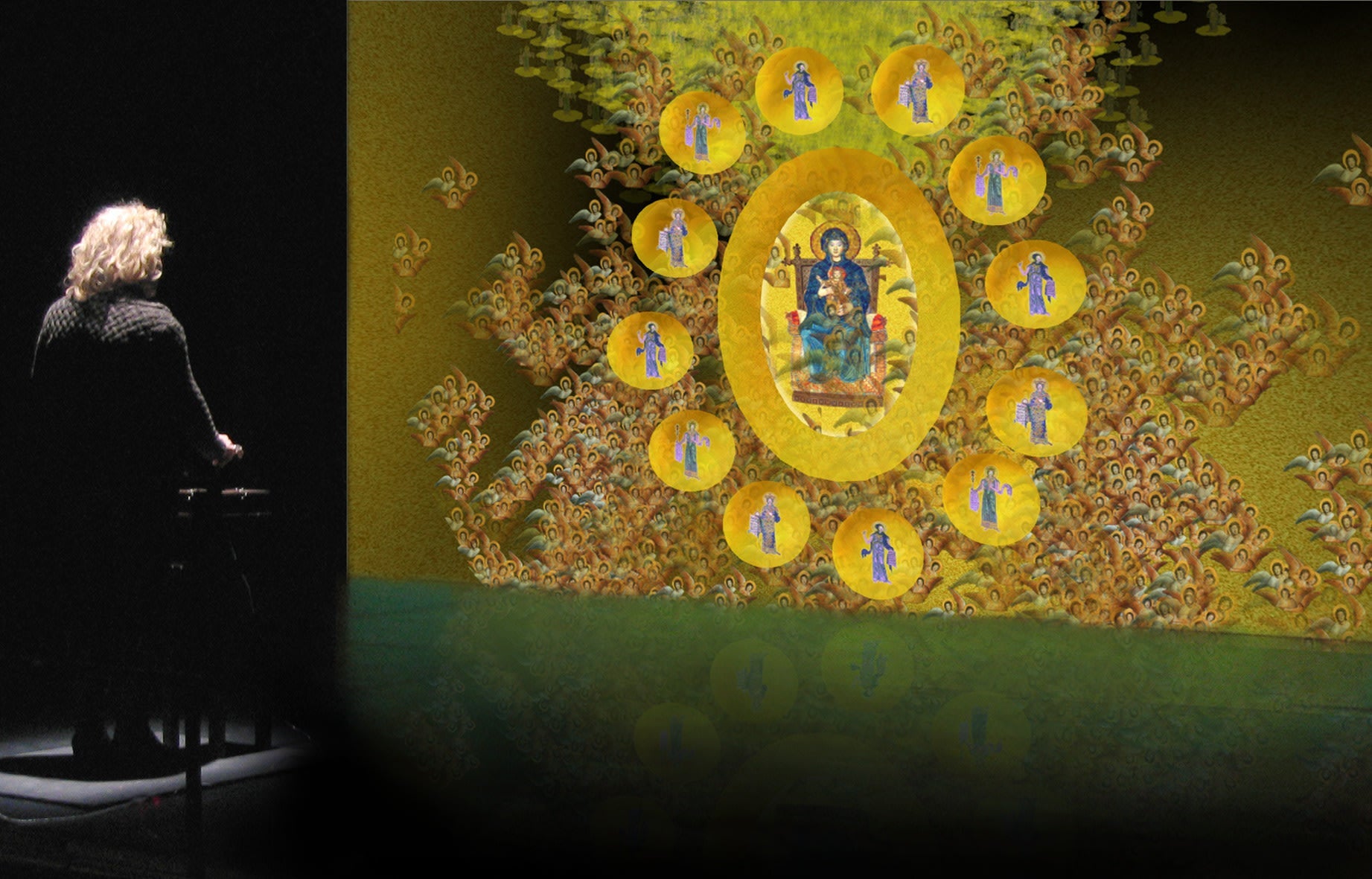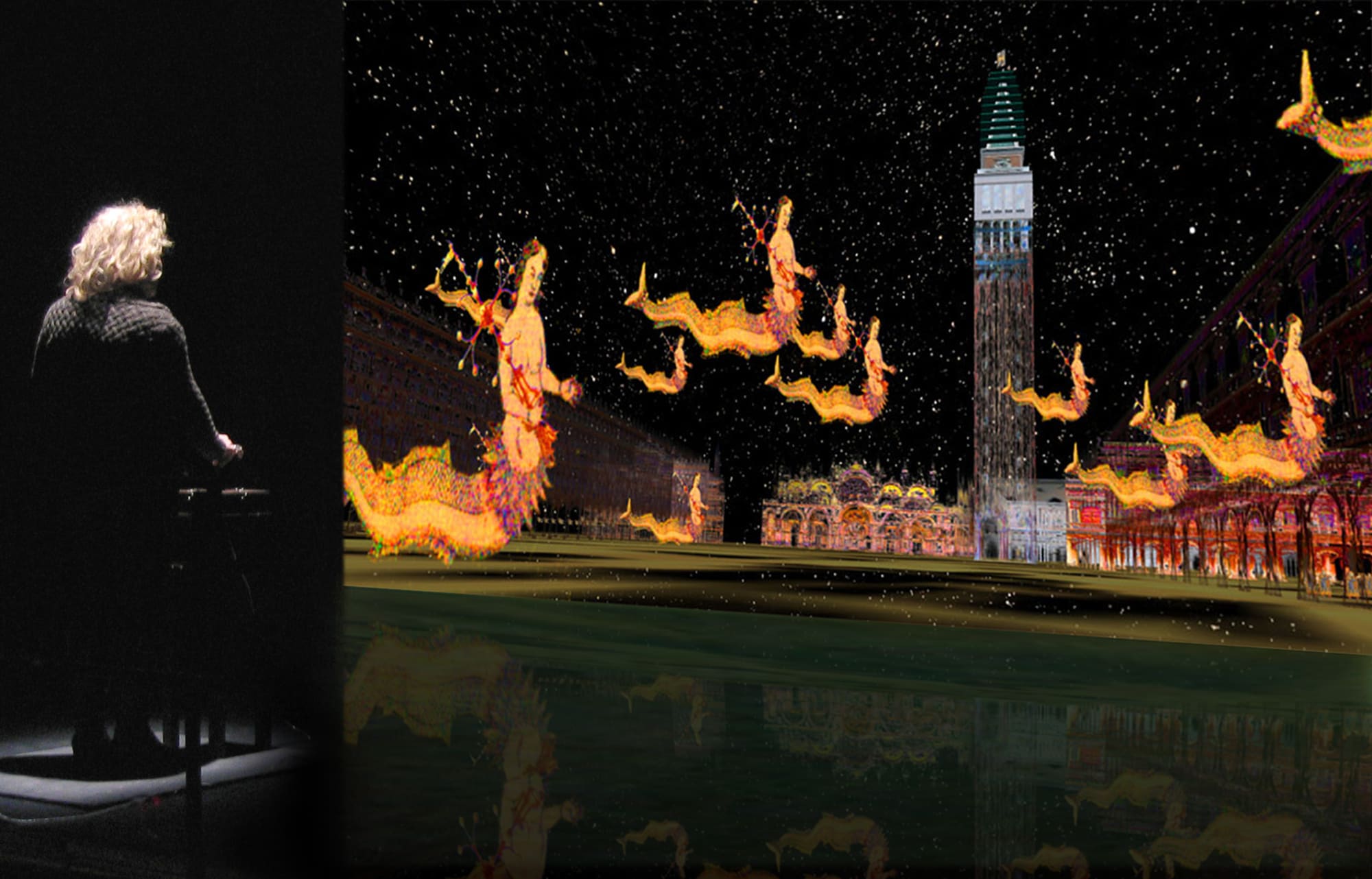- Play video
Travels of Mariko Horo, 2006/2017
3D virtual world as interactive large projection
Courtesy of Gazelli Art House Ltd.
Copyright The Artist
About The Artwork
The Travels of Mariko Horo
3D virtual world as interactive monoscopic large projection
By Tamiko Thiel, 2006/2017
Original music by Ping Jin, Professor of Music Composition, China Conservatory Beijing
Website: https://www.tamikothiel.com/mariko-horo/
Sometime between the 12th and the 22nd centuries, a woman journeys westward from Japan, travelling through space and time. She is searching for the "Isles of the Blest," the Buddhist paradise said to float in the Western Seas. She will be called Mariko Horo, Mariko the Wanderer.
In her travels she discovers mysterious, exotic Western cultures and peoples. She encapsulates her impressions in a series of "Horo-gramms," 3D virtual worlds. She invites you to visit her worlds and see the West through her eyes.
Music: The music is composed to sound “exotic” to both Western and Eastern ears. All pieces are original compositions from Professer Ping Jin, who composes music in both Chinese Classical and Western Classical traditions.
Artistic Background
The Travels of Mariko Horo is a "reverse Marco Polo" fantasy in which the fictitious Mariko Horo, a time-traveling Japanese woman artist, constructs the exotic and unknowable Occident. The user never sees Mariko, she is Mariko and explores the world through her eyes.
The piece was inspired by Japanese artists of the "Namban" genre ("Southern Barbarian" = Europeans). This genre existed between the 17th-19th centuries, while the country was closed to the outside world. Drawing on the few images and maps that reached the country, enhanced by their own fertile imaginations, these artists created fantasy depictions of an exotic, unknowable West.
In this VR installation I took images from Venetian and Byzantine art history, informed by Dante's Christian universe, and collided them with images from Japan, influenced by Buddhist cosmology. A vast virtual world with multiple heavens and hells branching off a sparsely built Venice, inspired by a map from the time of Marco Polo, it is an exploratory journey through space and time, a work of Namban Art for the 21st century.
Visual aesthetic: texture maps and particle systems
In the early 2000s, when I was developing this artwork, PCs could only run computer graphics with very low-resolution models requiring very crude geometric shapes. Coming from a fine art background, I wanted an aesthetic that looked toward the arts of drawing and painting. I made extensive use of “image textures” or “sprites,” 2D cut-out images that in a monoscopic projection create the illusion of a 3D figure. (See below for more about how I dealt with the technological limitations of the time.) I made extensive use of image textures in all my early works from 1994 – 2010, and then in The Travels of Mariko Horo extended this technique with the use of particle systems.
As mentioned in texts on my other works, particle systems are a computer graphic technique mostly used to depict swarms or clouds of natural elements, ranging from natural phenomena such as fire, clouds or water to swarms of creatures such as the bees and butterflies in ReWildAR. These are algorithmic systems in which the designer defines basic properties such as how many particles should be created per unit time, and what physical forces should act upon them. Once set in motion the designer has no direct control over them. The cloud or swarm constantly shifts and changes in ways that, especially in the early days of computer graphics, brought a rare sense of life into the otherwise often static and crude visual aesthetic.
Religious imagery often depicts supernatural beings as swarms of “heavenly hosts” or menacing demons floating in the air. The Travels of Mariko Horo was the perfect vehicle for me to explore the expressive use of particle systems in many different ways.
The video walkthough shows only one of the many possible paths through the virtual world. In the installation, each user seeks their own path, which might be very different. We begin in Mariko’s island house. A small bowl holding a model of Mount Sumeru – the centre of the world in the Buddhist universe – quietly lets off a cloud of divine faces, a portent of imagery to come. Outside, a flock of dolphins (made with mosaic images from Rhodes) plays around Mariko’s island. (Flocking algorithms are related to particle systems, using artificial intelligence concepts that use simple behavioural rules to produce what seem to be “intelligent” behaviours in swarms of “creatures.”) We get into Mariko’s gondola and set out to explore her world. We see only a few islands, each with only one building because Mariko has seen Marco Polo’s map and thinks this is how the West is built.
When we enter the lonely church, we step into a cosmos reigned over by Maria Kannon, a synthesis of the Madonna Maria and the Buddhist goddess Kannon. She is a real deity worshipped by the “Hidden Christians” of Japan, during the period when Japan was cut off from the rest of the world and Christianity was forbidden on pain of death. She and her hosts of angels are taken from Christian paintings and mosaics, but have Asian faces. (When imagining foreign worlds, I found that artists in both East and West depicted menacing foreigners fairly accurately, but gave their own features to foreigners or deities seen as benevolent.)
Here is Maria Kannon’s cosmos is another version of Venice. The campanile takes us down to the Piazza San Marco, in full 1:1 scale. Fish, mermaids and dancers populate the Piazza, all animated by flocking algorithms. In the Palazzo Ducale, the two giant Guardian Kings of Buddhist mythology guard the stairs. We ascend into a great cloud of writhing figures – all taken from Tintoretto’s giant mural “Il Paradiso” in the Palazzo’s Hall of the Great Council. The second set of stairs takes you into the arms of the avogadori, Venice’s public prosecutors. (They come from a painting in the Sala dell’Avogaria, but have Asian faces.) The avogadori bring you into the heavens to face justice for your sins: Christ, taken from the main mosaic in the Basilica San Marco, but here an angry god, presides over Venice with hellfires below and rows of heavenly hosts above. The blessed ascend to his right hand, the damned fall to his left. We fall into hell, a city in flames.
Mariko’s world is formed on Buddhist tenets, so when you die you are reborn. Your previous life however affects the world you are born into. Since we came out of hell, the world is now a darker place. Klu Klux Klan figures patrol the ruins of a burnt-out world.
If we enter the small white clapboard chapel on another island, the floor beneath our feet gives way. We plunge into a grey limbo where the damned of past US wars are guarded by Klan members with crowbars. We die again, but this time we have learned from our past mistakes and go to the right hand of Christ.
We ascend to Dante’s highest, crystalline heaven, where millions of Maria Kannon welcome us to her perfect universe. We, humans, are restless, however … when we try to approach her she dissolves into a benevolent cloud, allowing us to be reborn yet again. Waking up again once more in Mariko’s house, we see Venice transformed into a paradise garden. We sally forth to try yet again to discover our fate in Mariko’s world.
Technology: monoscopic virtual reality projections as immersive installations
Before 1994, computers that could run interactive real-time 3D computer graphics – that we called virtual reality back then, even if it was just on a monitor – cost upwards of $100,000. By 1994 however, several companies brought out 3D computer graphic platforms that could run on $5,000 high-end PCs. This technology evolved into the 3D computer games we know now.
My first work in virtual reality was using one of these platforms at the start-up company Worlds, Inc. in San Francisco. I was producer/creative director for Starbright World (1994-1997), the world’s first online 3D virtual world for children, in collaboration with Starbright Foundation chair Steven Spielberg. My subsequent independent artworks from 1994 – 2010 all used this type of technology, in the Virtual Reality Modeling Language (VRML) browser from blaxxun Interactive.
At this time, stereo VR headsets were large, uncomfortable to wear, and even the most powerful computers could not deliver a very high frame rate. As a result, most people could only be in virtual worlds for about 10 minutes before getting motion sickness. Since the technology was extremely expensive, it could also only be experienced at research laboratories or at a very small handful of media art venues worldwide.
Then as of now, my art practice focused on social and cultural themes. I wanted to reach a broad audience, and enable groups of people to view the experience together. I chose therefore to display my VR works as interactive, monoscopic wall projections, with the user standing close enough to the projection so it fills their peripheral vision. If the image is life-sized and reaches all the way down to the floor, their eyes tell their body this is not a window, but a space into which they can enter. With a very simple joystick even small children, the elderly and the physically impaired can navigate easily through the virtual space. The constantly shifting visual parallax of their movement enhances the feeling of moving through 3D space, underscored by spatial sounds embedded in the virtual world that get louder or softer depending on your distance from the sources.
This is a way that groups, or entire families, can view the artwork together. The children instantly grab the joystick and show their parents and grandparents how to move through the virtual world. The adults can tell the children what they are seeing, and what is happening as they move through the scenes. Since there is no stereo, users can explore vast distances without the time limitation problems of wearing a headset, or the motion sickness problems that come from moving long distances through a virtual world. Stereo VR brings a wonderful sense of presence and immediacy, but monoscopic large screen projections provide a fascinating shared experience in vast virtual worlds that VR headsets cannot yet provide.
Media artworks often go obsolete in a few years, as the technology changes. Luckily, after blaxxun went bankrupt in 2002 their technology was developed further by Bitmanagement Software. In 2017 I upgraded many images to a higher resolution and migrated The Travels of Mariko Horo to Windows 10 using the Bitmanagement 3D browser. Today, this 16 year old virtual world runs better than ever.
About Tamiko Thiel
Tamiko Thiel is an American artist, known for her digital art. Her work often explores "the interplay of place, space, the body and cultural identity," and uses augmented reality (AR) as her platform.
Thiel is based in Munich, Germany.









